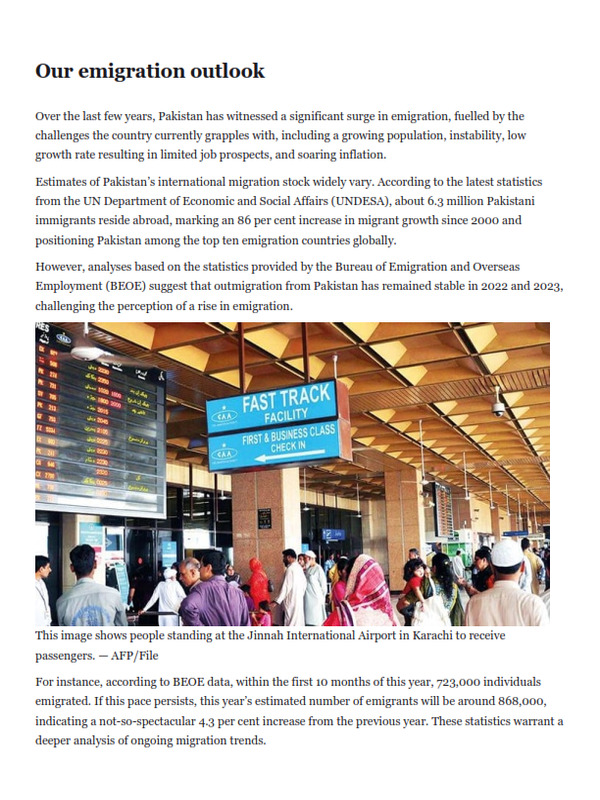Our emigration outlook
Over the last few years, Pakistan has witnessed a significant surge in emigration, fuelled by the challenges the country currently grapples with, including a growing population, instability, low growth rate resulting in limited job prospects, and soaring inflation.
Estimates of Pakistan’s international migration stock widely vary. According to the latest statistics from the UN Department of Economic and Social Affairs (UNDESA), about 6.3 million Pakistani immigrants reside abroad, marking an 86 per cent increase in migrant growth since 2000 and positioning Pakistan among the top ten emigration countries globally.
However, analyses based on the statistics provided by the Bureau of Emigration and Overseas Employment (BEOE) suggest that outmigration from Pakistan has remained stable in 2022 and 2023, challenging the perception of a rise in emigration.
For instance, according to BEOE data, within the first 10 months of this year, 723,000 individuals emigrated. If this pace persists, this year’s estimated number of emigrants will be around 868,000, indicating a not-so-spectacular 4.3 per cent increase from the previous year. These statistics warrant a deeper analysis of ongoing migration trends.
The BEOE’s annual placement data primarily reflects Pakistani worker placement in the Gulf region, notably in Saudi Arabia and the UAE, comprising roughly 96 per cent of the total from 1971 to 2023. However, this dataset offers a limited perspective, undercounting or entirely omitting migration to diverse destinations such as the UK, the US, Canada, Australia, Italy, Germany, Spain, Norway and Ireland. Additionally, the statistics lack information on return migration, a significant factor given the absence of a naturalization pathway in Gulf countries.
Another point worth noting is that BEOE data predominantly includes unskilled and semi-skilled workers, overlooking professionals like doctors, teachers and IT experts. Besides, the database neglects movements related to family reunification, education and settlement of asylum seekers in Western countries.
UNDESA statistics on migrants’ stock, in contrast, are more comprehensive and show that 54 per cent of Pakistani migrants reside in the Gulf States, with Saudi Arabia and the UAE hosting the largest populations. Europe attracts 15 per cent, primarily in the UK, while North America, especially the US, accounts for 10 per cent, with the remaining migrants residing in other parts of the world.
This implies that the current migration wave is not confined solely to unskilled and semi-skilled workers heading to Gulf countries. It also includes a growing number of qualified and educated young individuals seeking better opportunities in Western countries and some East Asian nations. Statistics made available by individual countries also points in this direction.
Australia, for instance, has emerged as a prominent destination, with a 40 per cent increase in arrivals by October 2023, reflecting a growing appeal for work, study, and family reunification. Pakistan consistently ranked in the top 10 countries from 2016 to 2022 in Australia’s Skill Stream Outcome programme. Also, student visas in 2022-23 showed a three-fold increase compared to 2021. However, these trends are not represented in the BEOE dataset, as Australia is absent from its list of destination countries.
Likewise, emigration to the UK has seen a substantial increase, particularly in work and student visas. Notably, there has been an overall 34 per cent increase in visa applications in the first three quarters of 2023 compared to the corresponding quarters in 2022, with work and study categories exhibiting impressive growth rates of 268 per cent and 51 per cent, respectively. The UK also saw a high number of student visa applications in 2022-23, boasting a remarkable 97 per cent visa grant rate.
Similarly, the US experienced a surge in visa demand, indicating heightened interest among Pakistani immigrants. Student mobility to the US witnessed a 16 per cent growth in 2022/23 compared to the previous year, with 10,164 students coming from Pakistan. In Canada, Pakistan consistently ranks among the top 10 countries with immigrants, constituting 2.7 per cent of the immigrant population.
Educational mobility of Pakistani students has risen particularly sharply, with a focus on Western nations which provide the potential of permanent residency. Key destinations include the UK, Australia, the US, Canada, and Germany. Emerging destinations for Pakistani students include China, Malaysia, Japan and South Korea.
Finally, the BEOE focuses on legal departures, missing irregular journeys to Europe in particular. Despite being relatively small, the numbers of undocumented migrants are gaining policy attention. Pakistan’s rank in European arrivals rose from ninth in 2016 to seventh in 2023. First-time asylum applicants in the EU surged from 14,535 in 2013 to 32,975 in 2022, with a remarkable 57 per cent increase within the EU and a 48 per cent increase in non-EU countries. Many of these temporary refugees later intend to acquire permanent residence in these countries or consider them as transit point to reach other European nations. Primary destinations for Pakistani asylum seekers include Italy, Greece, France, Germany and Hungary.
BEOE statistics are likely to underestimate the true scale of migration trends, especially regarding Western destinations. Recent trends reveal a shift, with skilled workers actively seeking opportunities in Western nations. Aspiring migrants seeking better income and respect are drawn to opportunities for family settlement, a choice often lacking in the Gulf States. A survey by PIDE indicates that 44 per cent of Pakistanis express a desire to emigrate for increased respect, with the inclination to leave the country rising with income, though not significantly.
There is a need to establish a comprehensive migration data system. Collaboration between the Ministry of Overseas Pakistanis and various agencies, including the BEOE, OEC, POEPA, NADRA and FIA, is crucial in this regard. This coordinated effort will ensure accurate data collection, covering all migration aspects and contribute to evidence-based policymaking for effective migration management.
The writer works as senior research economist at the Pakistan Institute of Development Economics (PIDE), Islamabad and can be reached at:




